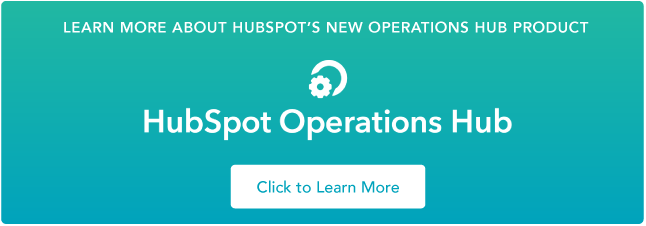Data reporting provides a meaningful and actionable view of how a business is performing. It connects the dots between disparate metrics and gives a true birds-eye view of individual roles, departments, and the company as a whole.

No matter the size of your organization, reporting is a must-have. It's also easier than ever for small businesses to implement cost-effective and straightforward data reporting. Let's look at how below.
Learn More About HubSpot's Operations Hub Software
Video Embed Module
HubSpot Video
What is Data Reporting?
Data reporting is the process of collecting, organizing, and visualizing raw data in order to assess a business's performance in real time and historically.
Data reporting is crucial to any business. It allows you to make data-driven decisions that generate business value, instead of decisions based on gut instincts that may or may not generate value.

Think of it like test-driving a car. It’s top-of-the-range, fresh out the factory, and you’ve heard great things about the model. Even though you have a good feeling about it, you’d probably be hesitant to set off without a clear view of the dashboard computer. No matter how respected the brand, you need to see how the car is running, and if there are any faults. It's a similar story with business.
Now that we understand the importance of a data reporting strategy, let's look at the difference between data reporting and business intelligence.
Data Reporting vs. Business Intelligence
Sometimes data reporting and business intelligence are talked about interchangeably, but that's not always correct. Here's how you can understand the difference:
Reporting shows you what has happened so far and what the status of your business performance is. This can include charts, graphs, tables, and other visualizations of performance on reporting dashboards.
Business intelligence (BI) shows you why things happened and helps to identify trends and risks to improve business performance in the future. With BI tools, you can explore and forecast metrics such as customer satisfaction, changes in demand, and cash flow.
With data reporting and business intelligence apps in your stack, your business can be in the best position to assess current performance, forecast how that will change in coming months, and react to trends and risks.
Types of Data Reporting
There are dozens of types of data reporting. Below we’ll look at some most common types. Each of these can help businesses track progress toward their goals.
Compliance Reporting
Compliance reporting typically provides information on how company and/or customer data is obtained, stored, distributed, and secured. This type of reporting is essential for showing that a company is adhering to all requirements set by a government or regulatory agency under a particular standard, like General Data Protection Regulation (GDPR) or Payment Card Industry Data Security Standard (PCI DSS).
Analytical Reporting
Analytical reporting combines qualitative and quantitative data to analyze a business strategy or process. The goal is to collect, analyze, and present data in order to determine what the next course of action should be.
For example, a market analysis could help a company decide how to best allocate their resources. If the analysis predicts that a particular market is growing and becoming more competitive, then the company may decide to allocate more resources into promoting that product.
Periodic Reporting
Periodic reporting provides summaries of performance data at fixed intervals. These intervals can be hourly, daily, weekly, monthly, quarterly, or yearly. Best for communicating performance to a group of stakeholders, this type of reporting provides a view of a company’s incremental growth.
Dashboard Reporting
Dashboard reporting provides a visual representation of the key performance indicators (KPIs) of a company or specific team. Integrating data from multiple reports and tools, dashboard reporting uses charts and graphs to provide an at-a-glance and multi-dimensional view of a company’s or team’s performance.
Dashboards, like the one shown below, can allow employees to get answers to their one-off questions quickly and easily.

How Small Businesses Can Implement Data Reporting
Not all reporting tools are equal. Although there are countless fancy analytics apps on the market, the best data reporting app is the one that your business can actually use and gain insights from. For small businesses, this often means simplicity and clarity, not complexity.
Before choosing a data reporting platform, understand what your business really needs from it. Here are some of the most important reporting features for most small businesses.
What to Look for in Data Reporting Tools
- Customizable dashboards and reports
- Simple user experience
- Ability to centralize data from multiple sources
- Range of reporting templates
- Range of chart types
- Professional design
- Ability to add notes for context
- Easy sharing with stakeholders
Now that we know what characteristics to look for, let's evaluate some of the best analytics tools below.
Top Analytics Tools for Small Businesses
There are two main ways for small businesses to implement data reporting: as part of a standalone analytics tool, or via functionality that's already integrated with their other apps.
Integrated reporting is offered with most cloud-based apps. This is the simplest way to get started with centralized data reporting.
However, if your apps don't provide sufficiently in-depth reporting, or you want to centralize insights from multiple tools, you can add a dedicated analytics app to your stack. Here are some of the best to shortlist for your business.
1. HubSpot
HubSpot's custom report builder is ideal for analyzing multiple data sources across HubSpot, including marketing and sales activities as well as objects (ie. contacts, companies, deals, tickets, etc). For example, you can create a report to measure how your target accounts are engaging with your website. It’s available with Marketing, Sales, Service, Operations, and CMS Hub.
Watch this video by Impulse Creative to learn how to generate reports with the HubSpot custom report builder:
2. Google Analytics
Google Analytics is among the most popular and straightforward ways to track your website traffic and performance. With this platform, you can create custom dashboards or use standard templates to monitor the performance of your marketing, content, products, and more.
3. Fathom
Fathom is a user-friendly app for financial intelligence that integrates seamlessly with Xero, QuickBooks, and Excel data. It's a fantastic choice for small businesses to take their accounting software's analytics further.
4. Futrli
Futrli is a financial prediction software that offers a clear, live, and customizable view of your business's performance and cash flow. It also analyzes customer and supplier data to alert you to hidden trends and risks.
5. Mixpanel
Mixpanel is one of the top product analytics platforms to help you convert, engage, and retain more users. With built-in behavioral analytics, data science, data governance, and user analytics infrastructure, Mixpanel is a great choice for SaaS, financial services, and ecommerce businesses.
6. Zoho Analytics
Zoho Analyics is a self-service BI and data analytics software that lets you visually analyze your data and discover hidden insights. Like the rest of the Zoho product family, it's optimized for small businesses.
7. Supermetrics
Supermetrics centralizes all of your marketing metrics, including PPC, SEO, social, and web analytics. Supermetrics also integrates seamlessly with Google Data Studio, Google Sheets, Excel, and Google BigQuery so you can present your reports on these platforms.
Data Reporting Examples
Quality beats quantity when it comes to data reporting, especially for small businesses. You can't track everything, so it's much more effective to stay on top of a handful of metrics that you can be sure are accurate and relevant.
But which metrics are worthwhile for small businesses to track? Here are some of the most valuable examples of data reporting that any business can implement.
1. KPI Dashboard
Best for: Providing a snapshot of your business's health
A KPI dashboard displays a visual overview of key performance metrics. Some of the best KPIs to include are website traffic, new contacts, new customers, and monthly revenue. With one glance, you should be able to tell how your business is performing, ideally against predetermined monthly and annual goals.
Here's an example of an acquistion-focused KPI dashboard in Google Analytics:

2. Website Performance Dashboard
Best for: Seeing how your website is performing and converting at-a-glance
If your small business is like most, your website is a vital sales and marketing channel. It's essential that it's functioning well, otherwise you risk losing valuable leads. The good news is you can easily monitor website performance with a simple dashboard powered by data from Google Analytics or a similar service. Some of the most important website metrics are page views, views per source (such as organic traffic, social media, and direct traffic), time on page, and bounce rate.
Here's a template of an Adobe Analytics dashboard for tracking website performance and conversions in Supermetrics:

3. Marketing Report
Best for: Analyzing marketing metrics to inform future decisions, strategies, and performance
It's easy to spend big on new marketing tactics. To identify what offers the highest return for your time and investment, you can create marketing reports to clearly measure which channels drive the most traffic leads or to identify top blog posts by conversion, for example.
Here's a an example of a channel-specific traffic marketing report in HubSpot:

4. Revenue Attribution Report
Best for: Analyzing the impact of your marketing and sales activities
Ideally, you want to tie each marketing and sales activity to revenue so you can understand which are creating revenue for your business. This might help you, for example, identify which channels and campaigns bring the highest-value leads that easily convert to customers.
Here's an example of a HubSpot revenue attribution report that shows deal revenue divided equally among all of the interactions that happened before the deal was closed:

5. Sales Pipeline Performance Report
Best for: Forecasting sales performance in order to prioritize your sales team’s efforts
Your KPI dashboard usually contains key sales metrics, but it's useful to have another report that digs into more details. This can visualize how many leads are in your sales pipeline and which stage they're at. First outreach, first sales call, and contract sent are just a few examples of stages you might use. Not only can this report forecast sales and revenue, but it can also help locate blockers and the areas that need streamlining.

6. Service Performance Dashboard
Best for: Tracking and improving customer service
Customer service and support is another key area to focus on. After all, if churn rates are too high, your investment in sales and marketing will be wasted. Helpful metrics to collect and track include customer satisfaction metrics (such as NPS and CSAT), churn rates, and ticket response times.
Here's an example of a detailed service report in Zoho Desk:

Best Practices for Small Business Data Reporting
For the most effective data reporting, pay close attention to the raw data you are working with. You'll have the best results when using data that is:
- Collected in real-time
- Integrated between apps
- Accurate
- Accessible and not stuck in silos
Since most reports need data from different and disparate applications and databases, integration solutions are a good option. Most small businesses, rather than building in-house integrations, go for integration platforms as a service (iPaaS) or a native integration to have entire databases in sync.
Once you're sure you have high data integrity, you can choose analytics functionality that effectively processes your data for relevant, timely, and actionable insights on engaging dashboards.
Start Relying on Data Reporting, Not Instinct
Instinct is valuable, but it isn't enough to determine how your business is performing. Data reporting enables you to measure the health of your business, no matter the size or industry, with accuracy and timeliness. With data-driven insights that allow you to fine-tune the areas that matter most, you can be confident that your business is heading in the right direction.
Editor's note: This post was originally published in December 2020 and has been updated for comprehensiveness.


